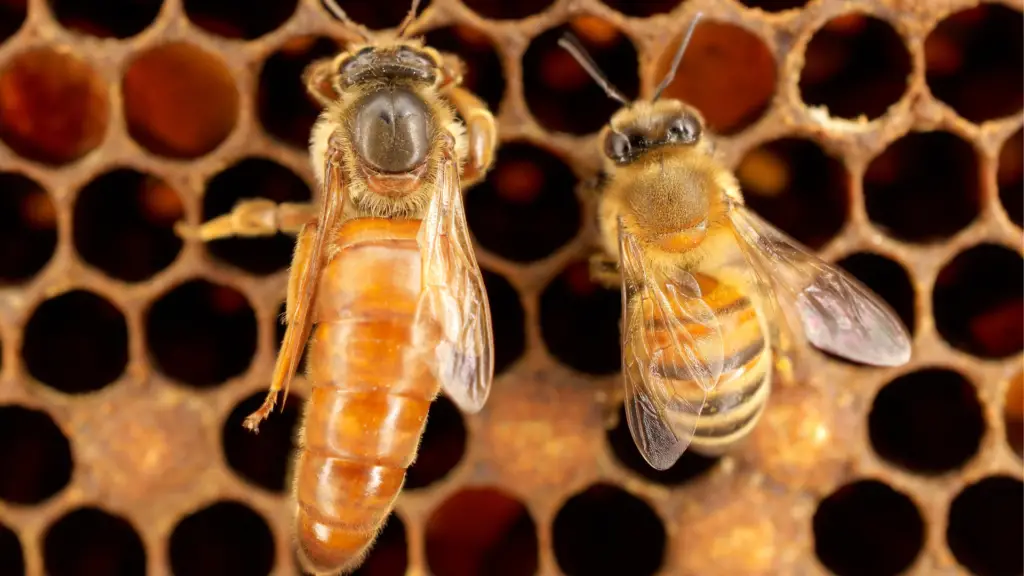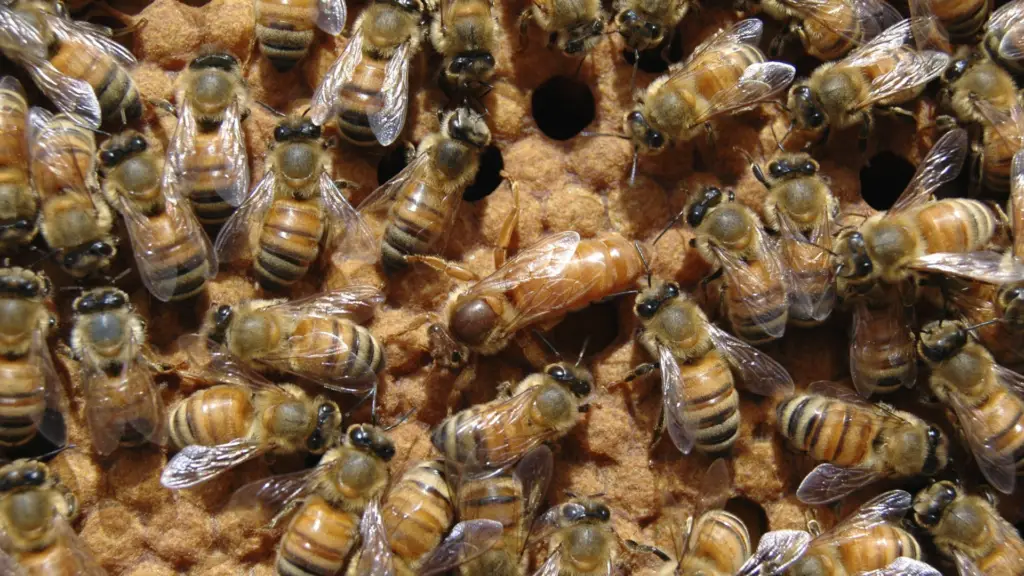The most distinct physical attribute of the queen bee is the long abdomen. The queen bee's wings remain short, only partially covering her abdomen. Also, her legs tend to be significantly larger than the drone and worker bees.
This post will highlight the visual differences between a queen bee and a colony worker or drone bee.
For new beekeepers and hobbyists, finding the queen bee may be difficult. But with a little knowledge and practice, you’ll be able to find your hives queen bee in no time.
What Does the Queen Bee Look Like?
A queen bee is similar to other females in the colony in several ways. Honey bees go through various developmental stages, and so does the queen bee. The stages progress from egg to larva, pupa, and adult. Click here to learn more about the lifecycle of bees.
Like all other insects, the bee has three major body sections – the head, thorax, and abdomen. They have six legs, two pairs of wings, eyes, antennae, and other crucial body parts.
The queen has a long, narrower abdomen that holds the ovaries.
Also, the queen honey bee has a spermatheca that stores the sperm collected from the mating process, which she uses for fertilizing eggs.
Unlike honey bees, she lacks pollen baskets because she never leaves the hive to collect nectar or pollen.
Click here to learn more about bee anatomy.


How to Identify the Queen Honey Bee
Size
The queen bee is the largest in the honey bee colony. She is generally narrower and longer in size than any other bee in the colony.
Abdomen
The queen bee’s abdomen is near the stinger, in the lower part of its body. In addition, it has a more pointed shape, while the other honeybees have blunt-shaped abdomens.
Legs
Queen bees also have six total legs. The difference between the queen’s legs and the workers is that they are positioned outward, making them more visible. The legs of worker and drone bees are also directly under their bodies, so spotting them from the top might not be easy.
Stinger
While the worker and drone bees have barbs on their stingers, the queen bees have an unbarbed, smooth stinger. You can inspect the stinger with a magnifying glass if you suspect the bee is a queen.
The Role of the Queen Bee
The role of the queen bee is to lay eggs so that the colony’s population grows or is maintained throughout the honey season. This activity is crucial because the fertilized eggs develop into worker bees, forming the colony’s workforce.
Worker bees are in charge of protecting the hive, raising the young, and bringing food.
In addition, the queen bee lays unfertilized eggs that develop into drones that mate with the new queens.
All of the queen bee’s work is typically done in the brood box of the hive. To learn more about brood boxes and honey supers, click here.
Also, the queen bee produces unique pheromones that aid communication within the colony. The unique pheromones help stabilize the mood of the hive and assure the colony members that everything is okay.
The lack of pheromones alerts the colony if the queen bee is missing. Her absence is felt within 15-30 minutes.
If the queen is away for longer than a few hours, the colony will immediately begin to replace her.
Life Cycle of the Queen Bee
The queen bee’s life cycle is the same as that of insects, and it passes through the egg, larva, pupa, and adult stages.
Drones (male bees) require 24 days to become mature. Worker bees, on the other hand, become adults within 21 days.
However, the queen bee only takes 16 days. She has the shortest development time in the colony. The queen bee feeds on royal jelly, a pollen and nectar protein mixture.
If a queen bee doesn’t perform as needed or becomes too old, the queen bee is replaced through a process called Queen Balling.
Once a queen dies, it’s important to introduce a new queen to your colony as soon as possible. Here’s our quick guide on buying a queen bee.

Searcing For & Finding the Queen Bee
Many new beekeepers find it challenging to find the queen bee, but you’ll soon become a pro with some practice.
Besides recognizing the outward appearance of the queen bee (detailed above), there are other ways to identify one quickly. Here are a handful of ways to search for and identify the queen bee;
- Start in the brood box. The queen will normally lay eggs within this separate hive chamber.
- Check the outer frames first, moving inward to ensure you have more room to work and you won’t miss the queen.
- Check the larvae areas. The queen lays eggs that turn into larvae, so she’ll often be nearby.
- Recognize her movement patterns. She often moves quickly throughout the hive and has an entourage of attendants that follow her.
- The queen may not be moving at all. When she stays still, the attendants form a flower-like pattern around her. She is fed by the rest of the hive and has no other duties besides laying eggs, so she may be the only bee doing nothing.
- Have a bee clip prepared to capture the queen once you find her.
- If you discover a “ball” of bees, this may be queen balling. The hive has decided to kill the queen to make room for a younger, healthier queen.
Marking The Queen Bee
Some beekeepers mark their queens with a colored dot on the bee’s thorax. This bright color makes it very easy to find later on.
Still, some beekeepers recommend not marking your queen as it is seen as a crutch. Training yourself to search for and identify the queen bee without markings will ensure you build your queen-spotting skills.

If you wish to mark your bees, consider using specific color designations to monitor your bee’s age and plan for your queen purchase and requeening process.
- White – years ending in 1 or 6
- Yellow – years ending in 2 or 7
- Red – years ending in 3 or 8
- Green – years ending in 4 or 9
- Blue – years ending in 5 or 0
Pro Tip: Model paint or paint pens are best for marking your queen.
Follow these instructions to mark your queen;
- Prepare your paint or paint marker supplies
- Gently pick up the queen by the wings or thorax. Or confine the queen to a small plastic box if you have one.
- Hold her over the hive in case you drop her. You’ll want her to fall back into the hive instead of the grass or other surface.
- Place a small dab of paint on the queen’s thorax between her two front legs. Take care not to use too much paint or paint other parts of her body.
- Allow the paint to dry slightly before gently returning the queen to the hive.
Practice Queenspotting
Don’t get down on yourself if you have trouble spotting your queen.
Expert beekeepers still have trouble finding their queens, and it only comes more naturally after you’ve had time to practice.
Luckily there are thousands of YouTube videos, TikTok videos, and “Where’s Waldo” style images throughout the web, so you don’t need a hive to get some queen-spotting practice.
Caring for Your Hive’s Queen Bee
Maintaining a proper habitat for your honeybees is one of the most important tasks as a beekeeper, and it all starts with understanding what wild bees love. Mimicking these habitat features can help ensure your hobby or commercial beekeeping practices are well worth the effort.
As for caring for the queen bee, here are a few tips to consider;
- Make the hive as comfortable as possible. Keep the hive free from glue, plastic, lumber, and paint smell. Use lemongrass and anise oil to suppress the smells and odors.
- Control the temperatures inside the hive by installing a shade to control high temperatures and overheating. For cold weather conditions, reduce the sizes of the entrance and exit holes, thus reducing the entrance of cold air.
- Block strong winds to prevent them from moving, swaying, or shaking.
- Provide proper ventilation in the hive to deter the bees from absconding due to unfavorable weather conditions. Adequate ventilation is not only essential for controlling extreme weather conditions. It also helps bring fresh air and get rid of foul odors.
For more info on supporting your queen’s and colony’s health, click here to learn about Brood Boxes & Honey Supers.

